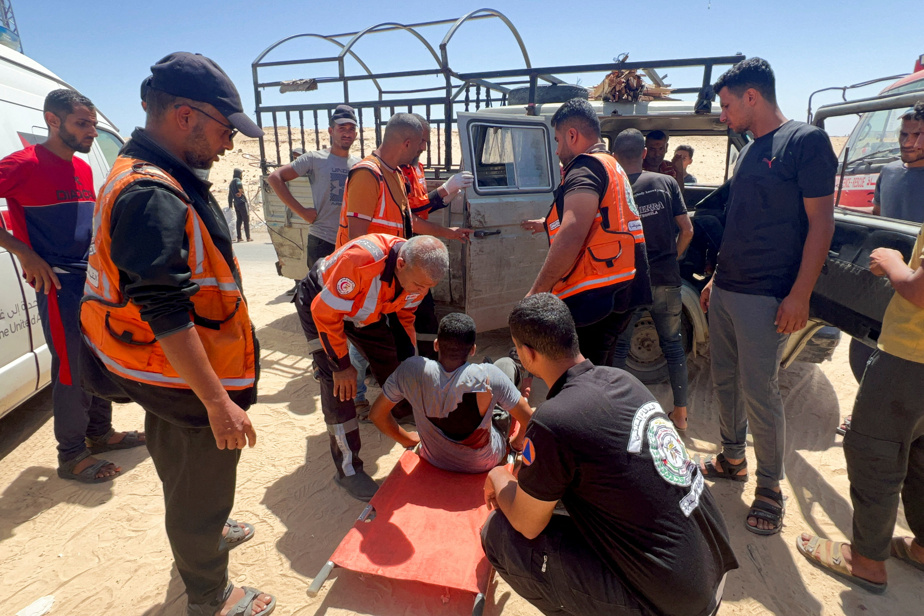(Rafah) Intense airstrikes and artillery fire targeted the town of Rafah, in the south of the Gaza Strip, on Saturday, the day after US President Joe Biden presented an Israeli road map in sight of a ceasefire with Hamas.
Israeli Prime Minister Benjamin Netanyahu, however, warned that the “conditions” for achieving a “permanent ceasefire” had not changed and included the “destruction” of the Islamist movement, in power in Gaza since 2007, as well as the “release of all hostages” held in the Palestinian territory.
Hamas had judged “positive” the road map unveiled Friday by Joe Biden and which aims to achieve, in stages and under conditions, a “permanent” ceasefire almost eight months after the start of the war, launched on October 7 by the bloody attack launched by Hamas against Israel.
The Israeli army, whose tanks entered the center of Rafah in recent days, continued its offensive on Saturday in this border town with Egypt, launched on May 7 in order, according to it, to destroy the last battalions of the Palestinian Islamist movement.
In 24 hours, the war left at least 95 dead across the territory, according to the Health Ministry of the Hamas-led Gaza government.

PHOTO ENAS RAMI, ASSOCIATED PRESS
A woman speaks on the phone as she sits in the rubble of her home following an Israeli air and ground offensive in Jabalia, northern Gaza Strip, on May 31.
In Rafah, operations are particularly concentrated in the west of the city, in the Tal al-Sultan neighborhood, where residents have reported shelling, tank fire and the movement of military vehicles.
“All night and until the morning, aerial and artillery bombardments did not stop for a moment in the western sectors of Rafah, preventing any movement of civilians,” a resident told AFP. from the city which has not revealed its name.
He added that Israeli shooters had taken up positions “on buildings overlooking the entire Tal al-Sultan neighborhood, making the situation very dangerous.”
Witnesses also reported heavy artillery fire in eastern and central Rafah.
In the center of the Gaza Strip, the Palestinian camp of Nousseirat was hit by airstrikes. In the north, artillery fire targeted the Zeytoun neighborhood in Gaza City, according to an AFP correspondent.
“Apocalyptic”
Since the start of the offensive on Rafah, at the southern end of the besieged territory, a million people have fled to the overcrowded coastal area of al-Mawasi, designated by Israel as a “humanitarian zone” to accommodate the displaced.
Life has become “apocalyptic” in certain areas of the southern Gaza Strip, the UN was alarmed on Friday.
“It is time for this war to end,” Joe Biden said on Friday from the White House, calling on Hamas to accept the Israeli plan which was submitted to it through Qatar. “We cannot let this opportunity pass,” he added.
The first phase, Mr. Biden said, would be a ceasefire with a withdrawal of Israeli troops from “inhabited areas of Gaza” for a period of six weeks.

PHOTO EVELYN HOCKSTEIN, REUTERS
President Joe Biden
The end of the fighting, according to him, would be accompanied by the release of certain Israeli hostages kidnapped on October 7 in Israel, in particular women and the sick, and the release of Palestinian prisoners held by Israel.
Of the 252 people taken as hostages, 121 are still being held in Gaza, of whom 37 are dead, according to the Israeli army.
This temporary ceasefire could become “permanent” if Hamas “respects its commitments,” added the American president. The next phase would include the release of all hostages still held.
“Hamas views positively what was included today in US President Joe Biden’s speech regarding a permanent ceasefire, the withdrawal of Israeli forces from Gaza, reconstruction and the exchange of prisoners,” Hamas said. indicated the movement.
” Glimmer of hope ”
“Israel’s conditions for stopping the war have not changed,” Mr. Netanyahu’s office said on Saturday, citing “the destruction of Hamas’s military and governmental capabilities, the release of all hostages and the assurance that Gaza will no longer pose a threat to Israel.
The political leader of Hamas, Ismaïl Haniyeh, for his part repeated on Friday that the “demands” of the movement, starting with a permanent ceasefire and a total withdrawal of Israel from the Gaza Strip, were “not not negotiable.
The war broke out on October 7 after the unprecedented attack launched by Hamas commandos infiltrated in southern Israel, which resulted in the deaths of 1,189 people, mostly civilians, according to an AFP count carried out in based on official Israeli figures.
In response, Israel promised to destroy Hamas, which it considers a terrorist organization along with the United States and the European Union.
His army launched an offensive that has so far killed 36,379 people in the Gaza Strip, according to data from the Gaza government’s Health Ministry, and caused a major humanitarian catastrophe.
The announcement of the new Israeli road map sparked reactions of hope across the world. UN Secretary-General Antonio Guterres called on Israel and Hamas to “seize the moment” to achieve “lasting peace in the Middle East.”
The proposal “offers a glimmer of hope and possibly a way out of the conflict,” according to German Foreign Minister Annalena Baerbock.
“We cannot let this opportunity slip away,” commented the Hostage Families Forum in Israel, calling on civil society to mobilize to push political leaders to accept and implement the proposal.
